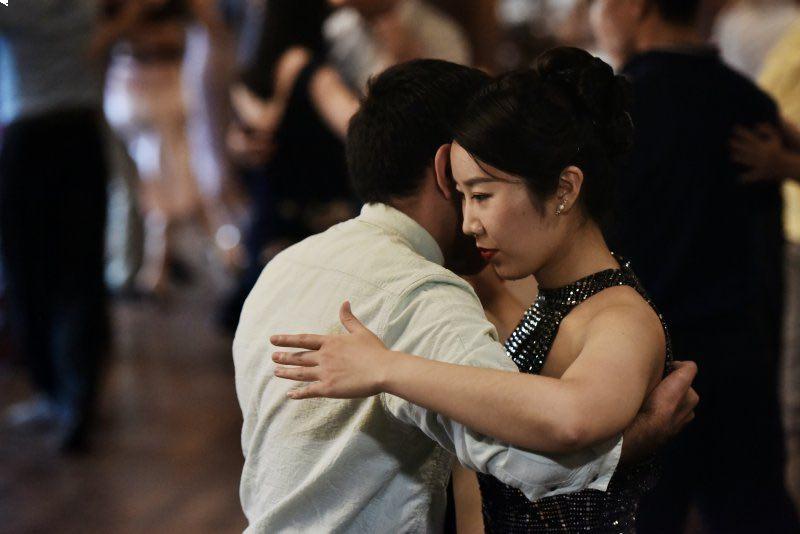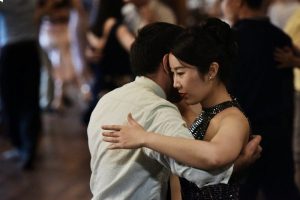Nonverbal communication represents 60 to 70% of a human being’s communication. We use it every day, unconsciously and mostly to communicate our emotions toward a situation, an idea or a person, without using words. It is proven to be more efficient than our speech.
As a ballroom dancer, I learned to observe and understand nonverbal signals from my dance partners mainly through social dancing. On a social dance floor, dancers will usually switch partners at the end of each song. Most people will dance with an average of 10 to 20 different partners for a night of social dancing. Each person you will get the chance to dance with has a different feel, a different music interpretation, different moves in their repertoire and their own way to interact as a whole.
Compared to competitive dancing, social dancing has a lot more room for improvisation, which asks both parties to be more attentive toward one another.
At a social dance, your communication tool is your body, your subject of conversation is dictated by the music being played.
The key is about listening to each other and not “talking” at the same time. This is why we call both partners a leader and a follower, disregarding gender. On a common agreement, the leader starts the phrase, the follower will continue it and a conversation can start (like a ping pong game) until the song ends.
The nonverbal communication begins the moment you have to look for a partner to dance with.
1/ Posture
During a social dancing party, anyone who wishes to dance the next dance will look around them with obvious interest. They’ll look to see where their own friends are sitting, or perhaps to locate new people that they think they might like to dance with. They will also try to notice who else is actively looking around, and thus draw up a shortlist of prospective partners.
Posture is a nonverbal communication that everyone can read. It is often one of the clearest signifiers of a person’s energy, mood, and level of attentiveness.
If a dancer has a good posture, they might inspire confidence, openness, and show charisma. On the other hand, if someone has hunched shoulders and slouchy back, they might appear to be tired, shy, or even sad or depressed.
So when looking for a partner on the dance floor you may naturally be attracted by the ones that are holding themselves more upright (Yes, you should have listened to your parents who told you to pay attention to your posture and no, it is not too late to work on it…)
Be curious about posture, notice how you respond to the posture of others, and pay attention to how your own posture might communicate your emotions.
2/ Eye Contact
Unlike other dances where people are more upfront, Argentine tango uses a traditional method of inviting and accepting invitations to dance based on non-verbal signals. This process is called the Mirada (or glance) and the Cabeceo (or nod of the head). It’s a very civilized and efficient way to arrange dances.
Before a dance, each dancer will look towards their preferred partner for a few moments and see whether their glance is returned. If not, they transfer their gaze to another, and then back again, or move on to another, until eyes do meet.
When you have accidentally met the glance of another and don’t wish to dance with them, look away. If you do wish to dance, each person offers the other a small gesture of acknowledgment. Typically the man may nod his head slightly towards the dance floor, and the woman will acquiesce (or the other way around). An agreement has now been reached and if it was a refusal, it was discrete, and not observed by anyone else.
3/ Touch
After agreeing to dance with each other, the first physical contact can be made through holding hands. Or maybe in a closed position which implies a bit more body touch.
Let’s assume you start by holding hands. That hand hold tells you already what kind of dancer you are dealing with (similar to a hand shake!). Does the person have a fish hand, a gentle and welcoming hand, a confident hand, or a more stiff and controlling hand?
Most non-dancers find the idea of holding the hand of a stranger uncomfortable. However, for social dancers, the intention behind that hand hold is for a dancing purposes rather than affection, and that can be sensed (still similar to a hand shake!)
4/ Space
Some dances may have a closer body contact that you would like. As an example, bachata sensual, caribbean zouk, or blues dancing can have higher body contact rate than salsa or swing. Space conveys messages about your comfort level, your desire to support or connect with others, and more.
Everyone has a different comfort level when it comes to space, observe and respect yours first. Be aware that your feelings may change from day to day and from person to person.
5/ Body Positioning and Gestures
As a follower, you can read a lot of different indications through the body position of your leader and the placement of the hands.
Imagine someone telling you which way to go. Their body is open toward the direction you should follow and their arms rotate to confirm the direction. Usually it is very clear and you don’t have to think twice.
In the same way, your partner will tell you where to go for the pattern they want to execute.
As a leader, observe the body position of the follower in a turn, you will know if she is balanced or if she needs your help to stay on her feet. Also, would you like to lead an under arm turn like a professional? Lift your arm and 75% of the job will be done!
Most people think leading is about pushing and moving the follower around. In reality, it’s about making your body positions and gestures clear and well timed to the music.
6/ Movement
The difference between an experienced dancer and someone who is newer is the way they move. Even an audience member who is not trained can see the beauty and fluidity of an experienced dancer. This is true, even though they do not know why. An experienced dancer is more coordinated, stable on their feet, more powerful, more efficient. The newcomer would appear more stiff, locked in their joints, not as in control.
It results in giving an indication on the comfort level of the person in their own bodies as well as their dance skills. Movement can be practiced and improved for everyone willing to invest the time.
7/ Facial Expressions
Our face holds about 43 muscles, and facial expressions can tell you a lot about how your partner feels on the dance floor. Are they happy, smiling and having a good time? Focused on their dance and frowning slightly because they are concerned about executing their steps to perfection? Widening their eyes because you decided to show them your signature moves, and they weren’t ready for it?! This is just a sample of interpretation that can be seen on the dance floor.
Social Dancing Is a Way to Express Yourself, Listen to Others, & Communicate
Social dancing is a very obvious way to express ourselves nonverbally. But communication is what we do on a daily basis, and it’s truly the dance of life. By learning social dancing, you can start to deepen listening, expression, and communication skills, all while having a wonderful time.
Sophie Cazeneuve

